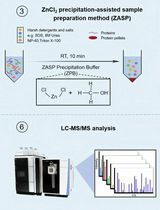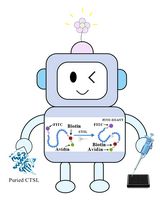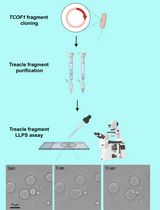- EN - English
- CN - 中文
Reverse Phase-high-performance Liquid Chromatography (RP-HPLC) Analysis of Globin Chains from Human Erythroid Cells
人类红细胞珠蛋白链的反相高效液相色谱(RP-HPLC)分析
发布: 2021年01月20日第11卷第2期 DOI: 10.21769/BioProtoc.3899 浏览次数: 3575
评审: Annamaria AprileFuming LiAnonymous reviewer(s)
Abstract
β-hemoglobinopathies are severe genetic disorders characterized either by the abnormal synthesis of the adult β-globin chains of the hemoglobin (Hb) tetramer (βS-globin chains) in sickle cell disease (SCD) or by the reduced β-globin production in β-thalassemia. The identification and quantification of globin chains are crucial for the diagnosis of these diseases and for testing new therapeutic approaches aimed at correcting the β-hemoglobinopathy phenotype. Conventional techniques to detect the different Hb molecules include cellulose-acetate electrophoresis (CEA), capillary electrophoresis (CE), isoelectric focusing (IEF), and cation-exchange-HPLC (CE-HPLC). However, these methods cannot distinguish the different globin chains and precisely determine their relative expression. We have set up a high-resolution and reproducible reverse phase-HPLC (RP-HPLC) to detect and identify the globin chains composing the hemoglobin tetramers based on their different hydrophobic properties. RP-HPLC mobile phases are composed of acetonitrile (ACN) that creates a hydrophobic environment and trifluoroacetic acid (TFA), which breaks the heme group within the Hb tetramers releasing individual globin chains. Hb-containing lysates are loaded onto the AerisTM 3.6-µm WIDEPORE C4 200 Å LC Column and a gradient of increasing hydrophobicity of the mobile phase over time allows globin chain separation. The relative amount of globin chains is measured at a wavelength (λ) of 220 nm. This protocol is designed for evaluating globin chains in (i) red blood cells (RBCs) obtained from human peripheral blood, (ii) RBCs in vitro differentiated from hematopoietic stem/progenitor cells (HSPCs), and (iii) burst-forming unit-erythroid (BFU-E), i.e., erythroid progenitors obtained in vitro from human peripheral blood or in vitro cultured HSPCs. This technique allows to precisely identify the different globin chains and obtain a relative quantification. RP-HPLC can be used to confirm the diagnosis of β-hemoglobinopathies, to evaluate the disease severity and validate novel approaches for the treatment of these diseases.
Keywords: HPLC (高效液相色谱)Background
Hemoglobin (Hb) is a tetrameric polypeptide composed of two α-globin and two β-like globin chains (ϵ, Gγ, Aγ, δ, or β). Hb is expressed in the erythrocytes and carries the oxygen from the lung to the tissues. Globin genes are differentially expressed throughout the development. For instance, during fetal life, the most abundant Hb is composed of two α- and two γ-globin chains (HbF, fetal Hb), while in human adults HbA, consisting of two α- and two β-globin chains, is predominantly expressed. Disorders caused by mutations in the β-like globin genes (β-hemoglobinopathies) represent the most frequent inherited diseases worldwide. In particular, β-hemoglobinopathies are caused by mutations that reduce adult β-globin production (β-thalassemia) or generate a mutant β-globin (sickle cell disease, SCD).
β-hemoglobinopathies are the most common monogenic disorders, therefore they represent ideal candidates for gene therapy approaches. A key parameter for determining the severity of the disease and the curative potential of treatment is the abundance of the different Hbs and globin chains. Indeed, techniques evaluating this parameter give insights into the degree of anemia (e.g., the α-/non-α-globin ratio, which is altered in β-thalassemia), highlight the presence of aberrant or uncoupled, toxic globins (e.g., α-globin aggregates in β-thalassemia) and evaluate the therapeutic expression of endogenous or exogenous β-like globins (e.g., fetal γ-globin, which is beneficial for both β-thalassemia and SCD).
Different methods can be used for the characterization and the quantification of Hbs and globin chains for the diagnosis and prognosis of Hb disorders, and for evaluating the therapeutic potential of gene therapy approaches.
Electrophoresis-based methods were firstly used to analyze Hb tetramers and globin chains. Erythroid cell lysates are commonly submitted to a cellulose-acetate electrophoresis (CEA) at alkaline pH. In this method, Hb tetramers migrate differently depending on their charge and are identified based on known Hb references (Schneider and Barwick, 1978; Wajcman, 2003).
More recently, capillary electrophoresis (CE) has been adapted to the analysis of Hb molecules. The separation of Hb molecules is based on their electrophoretic mobility at alkaline pH and is directed by pH and endosmosis.
Another conventional technique is the isoelectric focusing (IEF) that allows the separation of Hb molecules based on their different isoelectric point. Hb molecules migrate across a gradient until they reach a position where the net charge is zero. This method can distinguish some Hb variants that cannot be separated by CEA.
Finally, cation exchange-HPLC (CE-HPLC) can distinguish the different Hb molecules by chromatography using a salt gradient to elute them at a specific retention time.
All these methods give limited information on the amount of individual globin chains, in particular the γ-globin chains, Aγ and Gγ, which differ by a single amino acid. Moreover, in partially differentiated cell culture samples or chimeric models, these limitations are exacerbated by the presence of additional proteins or hybrid hemoglobin species. Finally, they often require a high amount of globin protein, which is difficult to obtain in in vitro generated RBCs or BFU-Es (Aprile et al., 2016).
Robust detection and relative quantification of individual globin chains can be achieved by reversed-phase HPLC (RP-HPLC), which separates proteins according to their hydrophobicity. RP-HPLC can be used for measuring the α-/non-α-globin ratio that is altered in β-thalassemia because of the reduced β-globin expression. Furthermore, this technique allows the measurement of both types of fetal γ-globin chains (Aγ and Gγ). These globins are highly expressed in adult life in genetic conditions known as hereditary persistence of fetal hemoglobin (HPFH). Fetal γ-globin chain expression can also be induced by targeting known γ-globin silencers to alleviate the clinical severity of both β-thalassemia and SCD (Cavazzana et al., 2017). Importantly, this method can be applied to in vitro generated erythroid cells as it requires a relatively low amount of globin chains to evaluate the therapeutic potential of gene therapy approaches (Antoniani et al., 2018; Weber et al., 2020). As for the above-mentioned techniques, RP-HPLC does not allow an absolute quantification of globin chains.
Materials and Reagents
P1000, P200, P20, P10 sterile tips
1.5-ml Eppendorf tubes
FisherbrandTM 9 mm Short thread Plastic vial, Wide Opening (Fisher Scientific, FisherbrandTM, catalog number: 11707597 )
FisherbrandTM 9 mm PP short Thread seal, Blue, Center Hole, Assembled Septum (Fisher Scientific, FisherbrandTM, catalog number: 11797567 )
AerisTM 3.6 µm WIDEPORE C4 200 Å, LC Column 250 x 4.6 mm (Phenomenex, catalog number: 00G-4486-E0 ), storage: 4 °C for long-term use
Acetonitrile for HPLC, gradient grade, ≥ 99.9% (Sigma-Aldrich, catalog number: 34851 ), storage: room temperature (RT)
Trifluoroacetic acid reagent grade > 99% (Sigma-Aldrich, catalog number: 76508 ), storage: RT
MilliQ deionized water, storage: RT
Lyphochek Hemoglobin A2 control (Bio-Rad, catalog number: 553 ), storage: 4 °C for short-term use or -80 °C for long-term use
Mobile phase (see Recipes)
Equipment
Laminar flow hood
Chemical fume hood
NexeraX2 chromatograph (Shimadzu)
HPLC UV-Vis detector SPD-20AV (Shimadzu)
HPLC degassing unit DGU-20A3R (Shimadzu)
Solvent delivery unit LC-30AD (Shimadzu)
Autosampler SIL-30AC (Shimadzu)
Column oven CTO-20A (Shimadzu)
System Controller CBM-20A (Shimadzu)
Refrigerated microcentrifuge (Eppendorf 5424 R )
Software
LabSolutions WS-Single LC (version 5.51) (Shimadzu)
Procedure
文章信息
版权信息
© 2021 The Authors; exclusive licensee Bio-protocol LLC.
如何引用
Readers should cite both the Bio-protocol article and the original research article where this protocol was used:
- Chalumeau, A., Frati, G., Magrin, E. and Miccio, A. (2021). Reverse Phase-high-performance Liquid Chromatography (RP-HPLC) Analysis of Globin Chains from Human Erythroid Cells. Bio-protocol 11(2): e3899. DOI: 10.21769/BioProtoc.3899.
- Weber, L., Frati, G., Felix, T., Hardouin, G., Casini, A., Wollenschlaeger, C., Meneghini, V., Masson, C., De Cian, A., Chalumeau, A., Mavilio, F., Amendola, M., Andre-Schmutz, I., Cereseto, A., El Nemer, W., Concordet, J. P., Giovannangeli, C., Cavazzana, M. and Miccio, A. (2020). Editing a γ-globin repressor binding site restores fetal hemoglobin synthesis and corrects the sickle cell disease phenotype. Sci Adv 6(7): eaay9392.
分类
生物化学 > 蛋白质 > 分离和纯化
您对这篇实验方法有问题吗?
在此处发布您的问题,我们将邀请本文作者来回答。同时,我们会将您的问题发布到Bio-protocol Exchange,以便寻求社区成员的帮助。
提问指南
+ 问题描述
写下详细的问题描述,包括所有有助于他人回答您问题的信息(例如实验过程、条件和相关图像等)。
Share
Bluesky
X
Copy link














